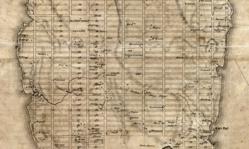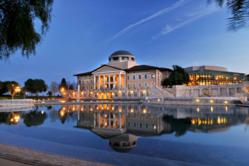
New York, NY (PRWEB) January 04, 2012
Exhibition Dates: December five, 2011April 15, 2012

The initial comprehensive exhibition to trace one of the most defining achievements in New York Citys historythe breathtaking vision, preparing, and implementation of Manhattans iconic grid systemis now on view at the Museum of the City of New York. The Greatest Grid: The Master Program of Manhattan, 18112011, on view from December 5, 2011 by way of April 15, 2012, documents the development of the Commissioners Strategy, which in 1811 specified numbered streets and avenues outlining equal rectangular blocks ranging from (todays) Houston Street to 155th Street and from First Avenue to Twelfth Avenue. The exhibition, which is organized on the occasion of the bicentennial of the strategy, elucidates, by way of remarkable maps, photographs, and other historic documents, this monumental infrastructure projectthe citys very first such civic endeavorwhich transformed New York throughout the 19th century and laid the foundation for its distinctive character. Some 225 artifacts are on view in the exhibition, which is organized chronologically and geographically, leading visitors from 17th-century, pre-grid New York via the organizing method and the explicit 1811 Commissioners Program, and from the enormous and elaborate implementation of the program to modern reflections on New York and visions for its future.

Commented Susan Henshaw Jones, the Ronay Menschel Director of the Museum: The 1811 grid was a bold expression of optimism and ambition. City commissioners anticipated New Yorks propulsive development and projected that the citystill fairly little at the time and concentrated in what is now Reduce Manhattan and Greenwich Villagewould extend to the heights of Harlem. The 1811 program has demonstrated outstanding longevity as well as the flexibility to adapt to two centuries of unforeseeable change, such as modifications such as Broadway and Central Park. The true miracle of the plan was that it was enforced.

Highlights of the exhibition are ten hand-colored maps by John Randel, Jr. (1787-1865), the surveyor, cartographer, and civil engineer who surveyed the island for the grid and produced the official 1811 Commissioners Strategy. Beautiful and utilitarian, the mapscalled the Randel Farm Mapsare among the most critical records of early New York, and they have in no way prior to been exhibited as a group. On loan from the Manhattan Borough Presidents Office, they dramatize the radical reorganization of the city that the grid required, and their presentation enables guests to examine the irregular topography of the city with the grid. The scale of these maps100 feet to 1 inchappears to be distinctive and uncommon among maps of other American cities.

Other rare and exquisitely detailed maps dating from 1776 to the present are on view, alongside beautiful archival photographs portraying the island of Manhattan all through different stages of excavation. An extraordinary street-by-street explanation of the program in the words of the commissionersGouverneur Morris, Simeon De Witt, and John Rutherfurdare on view as are other historic documents, plans, prints, and more.

The Greatest Grid is co-sponsored by the Manhattan Borough Presidents Workplace.

The exhibition is accompanied by a companion book of the very same title, co-published by the Museum of the City of New York and Columbia University Press. Dr. Hilary Ballon, University Professor of Urban Studies & Architecture at the Robert F. Wagner Graduate College of Public Service at New York University, conceived of the exhibition, is its curator, and is the editor of the companion book.

A associated exhibition, on view concurrently at the Museum, characteristics the benefits of a competition in which architects and planners have been asked for submissions employing the Manhattan street grid as a catalyst for pondering about the present and future of New York this exhibition is co-sponsored by the Architectural League of New York.

The Greatest Grid: Synopsis of the Exhibition
The Greatest Grid: The Master Plan of Manhattan, 18112011 traces Manhattans evolution from when-bucolic origins (depicted in a 1763 print portraying abundant greenery, soft rolling hills, and streams) to the densely constructed and populated metropolis it is right now. The original and authoritative Commissioners Planlines on paperreveals the conceptual vision that would grow to be one particular of the worlds greatest cities. 19th-century photographs on view reveal flat expanses, excavations, rock outcroppings, and other featuresnatural and man-madeas road-creating progressed and, in the words of Clement Clarke Moore, 1 of the citys first genuine estate developers, the surface of the earth [was reduced] as practically as possible to a dead level.

The exhibition documents the work of several illustrious figures, most notably, John Randel, Jr., who measured the grid with obsessive care. Randel was an apprentice to Simeon DeWitt, the surveyor basic of New York State from 1784 to 1834. Between 1808 and 1810 Randel measured the lines of streets and avenues at appropriate angles to every single other, and recorded distances and details about the island, its functions, and its inhabitants. This resulted in a manuscript map of the grid plan, which he completed by March 1811. Randel continued surveying the island from 1811 to 1817, setting marble monuments (one particular of which is on view in the exhibition there had been to have been 1,800) to mark the intersections of the coming grid. In between 1818 and 1820 Randel drafted a series of 91 big-scale maps of the island, now known as the Randel Farm Maps (ten of which are on view). An report written in the 1850s cited Randel as a single of our most correct engineers, further stating that his survey of New York City was done with such a mathematical exactness as to defy an error of half an inch in ten miles.

The commissioners detailed notes about the grid are also on view in the exhibition, explaining the program and expressing their intent to lay out streets, roads, and public squares, of such width, extent, and direction, as to them shall seem most conducive to public great… (From An Act relative to Improvements, touching the laying out of Streets and roads in the City of New-York, and for other purposes. Passed April three, 1807.)

Other colorful figures are highlighted, including William M. Boss Tweed, who implemented high-quality improvements, advanced solutions, and pushed forward many amenities even though at the same time benefitting his associates.

The merits of the grid are debated. Historians have viewed it as the emblem of democracy, with blocks that are equal and no inherently privileged web sites. Historians have also praised its utility, its neat subdivisions that assistance true estate improvement. The rectangular lots of Manhattans grid parallel Thomas Jeffersons national survey, which organized land sales in square-mile townships. The grid manifests Cartesian ideals of order, with streets and avenues that are numbered rather than named for trees, people, or areas. Frederick Law Olmsted bemoaned its dumb utility and lack of monuments and other characteristics. Jane Jacobs credited city streets with generating New Yorks public realm. And Rem Koolhaas called the grid the most courageous act of prediction in Western civilization: the land it divides, unoccupied the population it describes, conjectural the buildings it locates, phantoms the activities it frames, nonexistent.

The Greatest Grid reframes concepts about New York, revealing the plan to be much a lot more than a layout of streets and avenues. The grid offers a framework that balanced public order with private initiative. It predetermined the placement of the citys infrastructure, including transportation solutions, the delivery of electrical energy and water, and most other interactions. Manhattans grid has supplied a remarkably versatile framework for development and change.

Guests have the op
Find A lot more Loan Modification Services Press Releases


